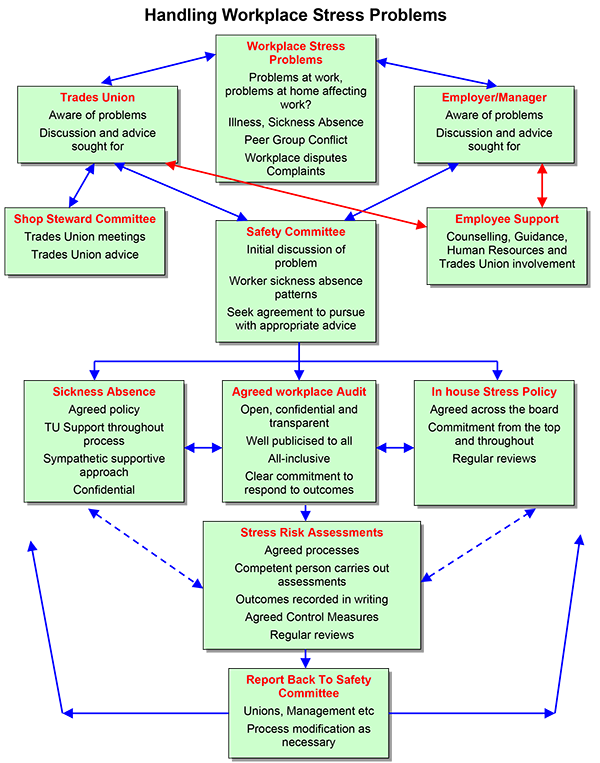How to identify the symptoms of workplace stress
Stress in the workplace can be assessed like any other risk if the matter is approached systematically. There are indicators which signal that danger is arising.
It is true that some work has a high stress factor or contains the potential of placing the worker in traumatising situations. Such work is usually recognised and those entering upon it are usually trained understand the issues. It is common for there to be in place measures to control the risk and to support the worker. Workers in these fields should, through trained and elected union representatives, have these measures constantly monitored for their effectiveness.
Most workers do not face these situations nor should this argument be allowed to excuse employers from taking action to protect workers' health. A sensitive objective study of the workplace can identify stressors in everyday work by using the process of risk assessment.
The following ideas are based on work done by a number of unions and are not intended to be a ' magic wand' process but it is hoped they will help to 'concentrate the mind'
Observe Yourself and Others
Stress, having a variety of causes, has a range of symptoms. By recognising these signs it can be identified. This list is based on a wide register of academic/trade union research.
Behavioural Symptoms
- Becoming irritable/aggressive, withdrawn, showing signs of social isolation.
- Showing signs of changes in eating habits, sleeping patterns consumption of alcohol, tobacco, tea/coffee, drugs, self-medication.
- Becoming more 'difficult' in the workplace less co-operative, more accident prone, less sociable.
- Becoming more 'difficult' outside work, decrease in social ease inability to cope with family/domestic roles, neglect of personal appearance.
Physiological Symptoms
Headaches, migraines, stomach disorders, raised blood pressure, changing sleep patterns, muscle spasms, back/shoulder/neck pain, a sense of feeling unwell, an unwillingness to work.
Psychological Symptoms
A growing feeling that the workplace is a 'threat', a place of anxiety, tension and the cause of irritability, low self-esteem, forgetfulness. An increase in worry about problems yet feeling powerless to change the situation. These changes can be felt in the individual who will not always be able to articulate them, but observation of fellow workers of attention to conversation will allow the trade union representative to notice the signs and begin to identify workplace sickness.
This should trigger a more formal study. Absence rates should be checked and any patterns noted. 'Presenteeism' (those attending at work but not working effectively) will also provide a valuable indicator of a developing problem.
Health and Safety Representatives can set in motion a systematic study of the workplace, after seeking advice from their union and also working with the employer, which will allow the stressors to be placed in order of importance and so tackled systematically. A number of large unions have useful information and advice available which will help in the setting up of questionnaires and in their analysis.
How does stress become recognised in the workplace?
Often the most difficult part of the whole process is getting workers themselves to acknowledge that there is a problem. Equally well, managers, employers and Board Directors will try to shy away from the concept, and say that people are wimps, should leave their baggage at home and should 'pull themselves together'. There is still a great deal of ignorance about.
In many cases, employers may just take the recommendations of the Hatton Appeal judgment, and suggest that counselling and other services will provide a resolution. They will also apply heavy sickness absence monitoring procedures and even move to dismiss on the basis that a known psychological illness must clearly make a person unsuitable for that workplace.
In organised workplaces, with good Trade Union and Health & Safety representative structures in place, there are forums for raising the issues of sickness absence and leading to proper discussion of the issue and to recognition by the employer that action is necessary.
Safety Inspection reports
Regular safety reports can flag up issues related to staff sickness absence rates. Employers keep data on sickness absence and although some aspects of this data are covered by Data Protection, general principles of looking at patterns of absence in workshops, sectors or the entire business are not. In such cases, it is possible therefore to discuss the impact of absence patterns and to examine the causes of them.
By raising the issue in Safety Committee meetings, early discussion can then lead to general acceptance within the organisation that there may be a problem to be addressed.
This can prompt discussion of the principles of Risk Assessment, the HSE Management Standards, and can therefore lead to simple or more sophisticated audit processes.
All such audits must be confidential, open and transparent and apply to all workers, including managers as necessary. Tabulation and publication of results data should not identify individual workers for possible targeting by critics. Within the process of moving towards a full Stress Risk Assessment process the normal procedures of any generic risk assessment apply.
The process is a cyclical one, allowing for full and frank discussion on causes and effects of workplace stressors, and to facilitate the implementation of control measures as well as the essential factor of recognition that the employer has a duty of care to the workforce.
The graphic below illustrates suggested procedures for handling workplace stress problems. If you wish to download a copy in .pdf format which is easier to read, please do so here.

